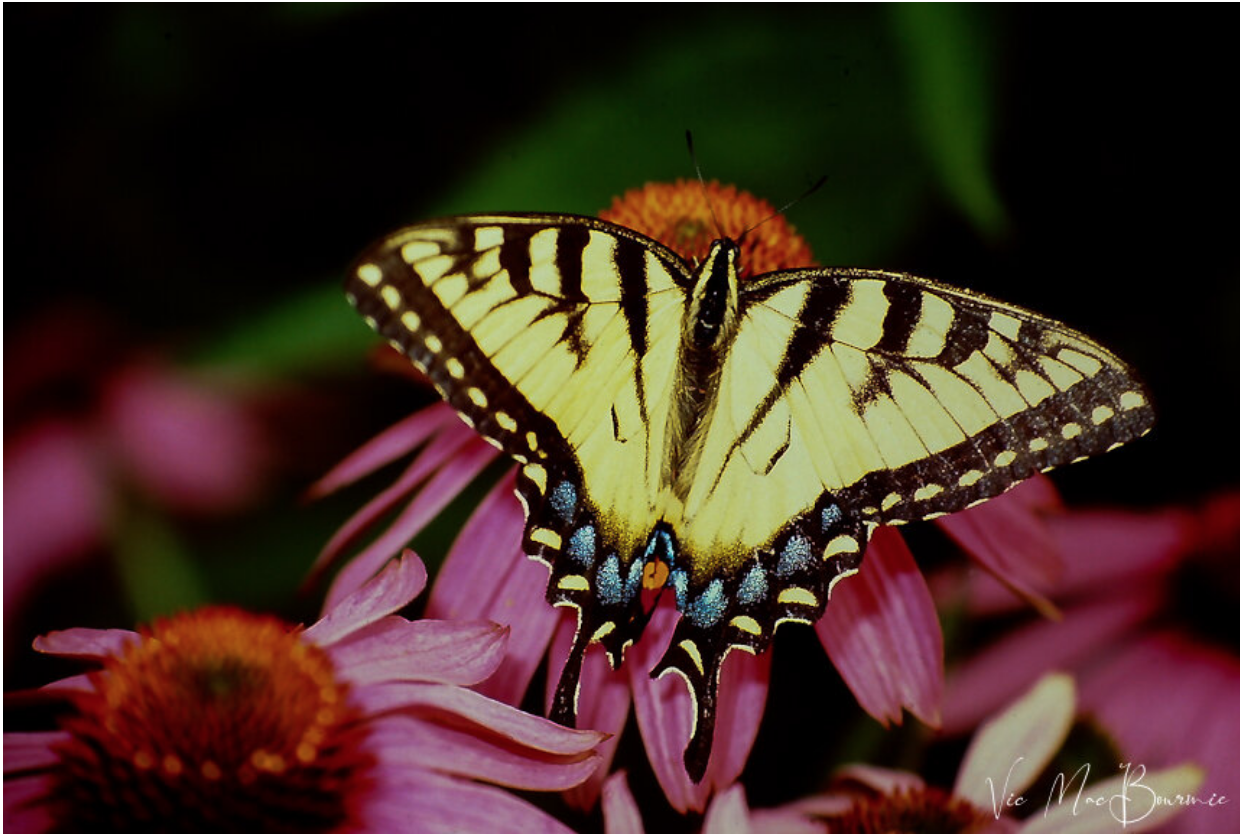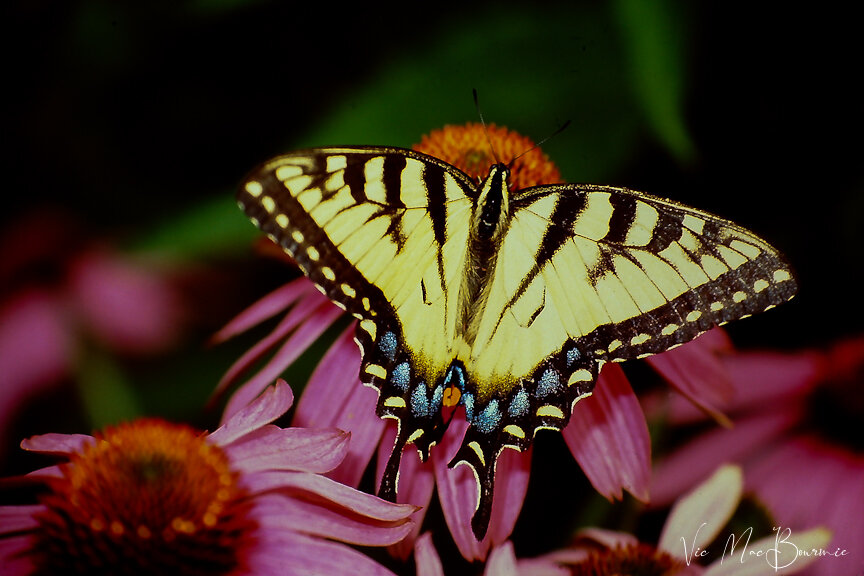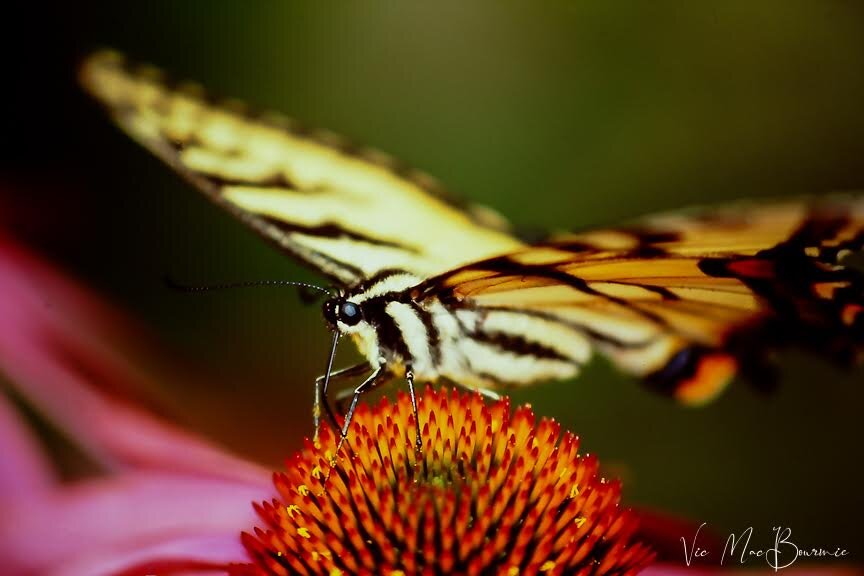Canada Anemone: A native ground cover for woodland garden
Canada Anemone is native ground cover that is ideal for the woodland garden that enjoys a little sun and would benefit from a fast-spreading ground cover with a lovely flower.
Native bees zero in on Canada Anemone
The Canada Anemone (Anemone canadensis) is an ideal choice for a native ground cover that will not only light up the woodland garden in spring when it is in flower, but will also create a lovely textural cover throughout the summer.
I started my little patch from a single plant purchased at the local horticultural society’s annual plant sale. In a few short years, that single plant quickly spread into a good-sized size drift that greets spring with their clear white flowers and yellow centres that can stretch out to be over an inch wide with five sepals held up on long stalks. The flowers stand above the foliage that resembles that of Wild Geranium. New foliage growth emerges a light green giving the plant a fresh look.
The drifts of flowers spread through rhizomes and depending on the soil they either spread quickly in rich, mesic to wet soils, but slower in drier, more well-drained soils. Our soil is definitely dry, but they still spread with great vigour. They can often be seen near sandy dry lakes as well as meadows.
The wildlflower is native to most of eastern North America and is common in the upper midwest and Great Lakes area where I live.
An aerial view shows the flower in both its open and un-open stages as well as the ferny foliage that resembles the foliage of Wild Geranium.
It is a favourite of the early native bees and other pollinators, but our resident rabbits and deer never seem to touch the plants. That could be because they are smart enough to know that all of the parts of the plant are considered toxic.
Making room in our gardens for more and more native plants is vital for the survival of our native fauna, from insects and caterpillars that have developed a relationship with these native plants over centuries, to our native birds that depend on the insects and caterpillars to feed themselves and, even more importantly, their young in the spring when insects are often difficult to find.
They flower about the same time as non-native Epimediums, which enjoy a more shady location. I can see some large drifts of these Canada Anemones growing together with clumps of Epimedium in a part-sun, part shade environment. The ferny foliage would work well with the larger, and more colourful foliage of some Epimedium throughout the summer months, once flowering has ended.
Our little drift will be contributing to more drifts throughout our garden when I transplant some of these original plants to different parts of the garden later this year when the flowering has dried up.
Looking for more information on ground covers? Please check out my other posts on ground covers I use in the woodland garden.
• Bunchberry perfect ground cover for woodland garden
• What is the easiest ground cover to grow?
• Three great ground covers for the woodland garden.
• Creeping thyme as a ground cover
Fall is a good time to transplant them but any time after flowering should be fine, especilly if you are transplanting them in shaded area and give them lots of water to help get them a good start.
These plants may look delicate, but don’t mistake their delicate beauty for weakness, these are a hardy, native ground cover.
Canada Anemones are perennials that grow well in zones 3-8 and reach about a foot tall when in flower.
Like any good ground cover, they are quick to spread and fill in those empty patches in your garden. Plant them in full sun to partial shade for best results and expect blooms from late May into June.
They prefer a wet to medium site but have done well in our dry sandy loam with a layer of mulch to keep the soil cool in the hot sun.
Growing Canada Anemone from seed
Growing these plants from seeds can be difficult.
The seeds actually need double stratification in a cold moist environment before germination and, therefore, could take up to two seasons before plants emerge if seeds are sown directly in the garden in fall.
Best to just get some plants from a friend or a good reputable native plant nursery.
What insects and pollinators are attracted to Canada Anemone
Any native flower that emerges early quickly attracts a host of insect pollinators and the Canada Anemone is no different. Watch for small Carpener Bees, Sweat Bees and Mining Bees visiting the flowers. A host of beetles are also attracted to the flowers, including long-horned and tumbling flower beetles just to name a few.
Obviously, backyard birds will also be checking out the early-blooming flowers for a quick meal of delicious insects.
Making room in our gardens for more and more native plants is vital for the survival of our native fauna, from insects and caterpillars that have developed a relationship with these native plants over centuries, to our native birds that depend on the insects and caterpillars to feed themselves and, even more importantly, their young in the spring when insects are often difficult to find.
Consider replacing non-native ground covers, such as Lilly of the Valley and Periwinkle, with native varieties that perform as well if not better than their non-native counterparts and provide important sources of food for native birds, mammals, reptiles and amphibians.
Another great flower for selective focus
When the Canada Anemone is blooming, it’s time to get out the camera and experiment with a little selective focus. Use a long lens and shoot through the flowers with your lens “opened up” to its widest opening. Now focus on a flower in the distance and let the foreground and background go out of focus.
You could get a similar effect with a macro lens by allowing the flowers in the foreground to go out of focus while focusing on a more distant flower or grouping of flowers.
Purple coneflower: Great native plant to attract butterflies and birds
Perfect for building a wildflower meadow
Few flowers light up a garden with bees and butterflies quite like Purple Coneflower.
Plant the native species of purple coneflower, spread the seeds around your garden and enjoy the benefits of these strong, upright native prairie-based plants that are truly magnets for swallowtails, painted ladies, monarchs, and an assortment of fritillaries.
Birds like them too, including hummingbirds that are attracted to the plant while it is in bloom and goldfinches, blue jays and cardinals who depend on the plants for its abundance of seed throughout the winter.
Stick with the Native coneflowers
More recently, coneflowers have become so popular that they are now available in a variety of colours including white, yellow, orange, red and even green. Plant them if you wish, but make sure the native species of coneflower (Echinacea purpurea) has a prominent spot in the garden.
The yellow coneflower (Ratibida pinnata) and thin-leaved purple coneflower are perfect companion plants to the more traditional purple cousin. They are also easy to grow, do well in a variety of soil types and are hardy from zones 3-7.
This beautiful yellow swallowtail stops at our purple coneflower to drink in its rich nectar.
A prairie meadow in your backyard for the bees, butterflies and birds
Most of us in southwestern Ontario stretching up into northeastern United States define our living and gardening area as the deciduous forest zone.
While this holds true for the most part, Lorraine Johnson writes in Grow Wild! Native Plant Gardening in Canada, parts of our gardening zones fall in “the most easterly range of the tallgrass prairie ecosystem.”
She writes: “For the gardeners whose lots are treeless and, for whatever reason, have no plans to plant trees, this sunny-meadow model can form the basis of a native-plant garden.”
What better opportunity to experiment with the Coneflower family along with black-eyed Susans and meadow grasses. Even a large sunny area in your woodland garden would be the ideal spot to create a native wildflower meadow garden.
The importance of these gardens cannot be underestimated.
In her book Our Native Bees, (see my article here) Paige Embry explores the concept of turning turf, or at least a portion of the lawn, into a prairie meadow to attract native bees and butterflies. She points to efforts made in the United States by golf courses to take advantage of great swaths of high-maintenance lawn and turn them into low-maintenance native prairie meadow.
“If the idea of flowers growing in the grassy lawn isn’t quite achievable yet, there’s always the golf course route. Take out some of that lawn and convert it into a home and dining hall for bees. It’s all a matter of rethinking normal,” she writes.
As one researcher at the University of Minnesota explains: “the hardest part of getting a bee lawn into use isn’t developing the seed mix; it’s dealing with people’s vision of what a lawn should be….”
If you are interested in creating a naturalized border or mini meadow, be sure to check out my post Fields of Gold: Sunflowers and Goldfinches.
Yellow Swallowtail sips from a purple coneflower.
Plant coneflowers from seed to save money
Don’t be surprised if your plant dies out after a time. In some situations, purple coneflower can be considered a short-lived perennial. Although your main plant may die off, by sprinkling the seed about the garden you should have a nice regular supply of the plants.
The good news is that they are great plants for those looking to save money and don’t mind growing them from seed. (For more ways to save money gardening, check out my earlier story here.)
They are easy to grow from seed. Collect the seed from your own plants, or from a neighbour’s plants (after asking them of course) or you can purchase them at your local nursery.
The seeds benefit from a cold-moist stratification method to break down the hard seed coat and ensure that it germinates at the proper time, however, coneflowers are not dependent on this for germination.
Germination is improved if the coneflower seeds are placed in a container of damp sand and placed in a refrigerator for about two months. In spring plant them directly in the garden or get a head start by using grow lights.
If all that sounds too complicated, just sprinkle them throughout the garden in the fall in areas you would like to grow a clump of them and exercise some patience. Nature will take care of th stratification process and the seeds should germinate in spring provided critters, including birds did not find them first.
Learn to know what the seedlings look like so you don’t mistake them as weed seedlings.
Are Purple Coneflowers easy to grow?
The plants are easy to grow in most soils, are not bothered by pests, require little to know fertilizer and can take some shade. For best performance, a sunny location is best.
The coneflower is hardy from zones 3-9, and native to Eastern and Central United States from Canada into more southern areas.
How large do coneflowers grow?
It grows to about 4-feet high, but can get to 5-feet under the right conditions. Flowering begins in about mid-summer and continues to flower through to the fall. Like Black-eyed Susans, definitely leave the flowers on throughout the winter months not only for their aesthetic value but, more importantly, as a valuable food source for birds.
The coneflowers’ strong stems and spent flowers stand high above even heavy snow accumulation to provide perfect landing spots for birds to feed on the abundance of seeds.
Plants grown from seed, either manually or naturally spread around the garden, can bloom in the first year, but expect to wait a full growing season before you see blooms on the plants.











